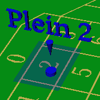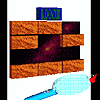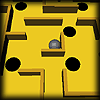
|
Collaborative Games in Augmented Reality
Playing games together supported by three-dimensional computer graphics
Project duration:
1998-
Contact:
Zsolt Szalavári
|
Description
|
We have developed a number of augmented games for multiple users, that allow players to play with each other, while the computer is only a high-quality supporting tool. Our approach opens a new field of augmented gaming where real and virtual content may be mixed and social communication necessary for a game scenario is not hindered.
|
Application
|
Interactive gaming is becoming more and more one of the dominant application areas for computer graphics. The related industry is growing very fast both in the location based entertainment (LBE) and the PC-game domain. We focus on a computer-based gaming environments for home usage which are suitable for multiple players in different games and scenarios.
|
Problems
|
Current hardware limitations are not convincing for players to change from traditional games to computer based virtual or augmented games. We have to develop methods for better performance, easier manipulation and last but not least techniques to support "fun".
|
Approach
|
Our solutions involve a
- hardware setup to diplay customized information for collaboration of different users in an augmented reality environment,
- networking solutions to distribute graphics to player clients,
- precision enhancing mechanisms to ease manipulation in augmented reality,
- powerful automatic privacy techniques for sequrity management (not only) in game scenarios,
- layering mechanisms to support visual privacy management.
A number of games have been developed to show how augmented reality can support gamig, and how these games benefit from interactive three-dimensional computer graphics and high-quality manipulation.
|
Publications
|

|
Games
|
A number of games that have been implemented to show the benefits of augmented gaming:
|
 |
Mah-Jongg:
We unified our approaches in Mah-Jongg - a very old traditional chinese board-game - which supports the ability to display different information to each participant, unhindered social communication, and precise and fast interaction with the game as the crucial factors for augmented gaming.
This game combines previous developments and is also based on the research projects Studierstube and thePersonal Interaction Panel.
|
 |
Virtual Casino:
The Vitual Casino application is an example using a Java-based behavior server, and a distributed viewer - NetIv - for OpenInventor. It enables multiple players to play Roulette on a virtual roulette-table using the Personal Interaction Panel as input device in the augmented setup.
|
 |
Blockout:
This game is the augmented version of it's early and famous ascensor "Blockout". Simulated physics of the ball to make it behave realistic in the real surroundings and interaction with augmented tools enhance the game experience in three-dimensions.
|
 |
Augmented PIP-Maze:
PIP-Maze is a close relative of the InventorMaze demo of SGI. However the our augmented version benefits from stereoscopic vision and two-handed direct manipulation on the Personal Interaction Panel.
|





